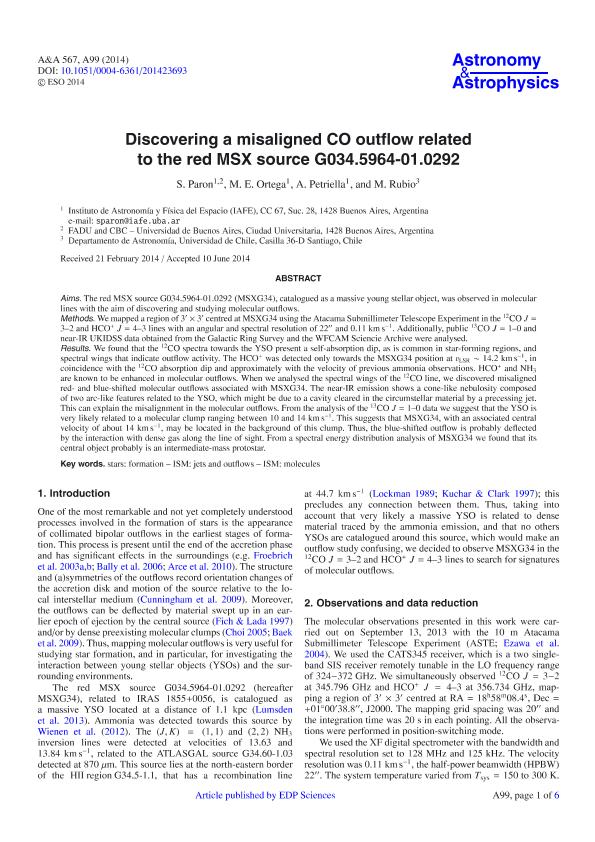Mostrar el registro sencillo del ítem
dc.contributor.author
Paron, Sergio Ariel

dc.contributor.author
Ortega, Martin Eduardo

dc.contributor.author
Petriella, Alberto

dc.contributor.author
Rubio, M.
dc.date.available
2017-06-01T20:59:33Z
dc.date.issued
2014-06
dc.identifier.citation
Paron, Sergio Ariel; Ortega, Martin Eduardo; Petriella, Alberto; Rubio, M.; Discovering a misaligned CO outflow related to the red MSX source G034.5964-01.0292; Edp Sciences; Astronomy And Astrophysics; 567; 6-2014; 1-6; A99
dc.identifier.issn
0004-6361
dc.identifier.uri
http://hdl.handle.net/11336/17329
dc.description.abstract
Aims. The red MSX source G034.5964-01.0292 (MSXG34), catalogued as a massive young stellar object, was observed in molecular lines with the aim of discovering and studying molecular outflows.
Methods. We mapped a region of 3′× 3′ centred at MSXG34 using the Atacama Submillimeter Telescope Experiment in the 12CO J = 3–2 and HCO+J = 4–3 lines with an angular and spectral resolution of 22′′ and 0.11 km s-1. Additionally, public 13CO J = 1–0 and near-IR UKIDSS data obtained from the Galactic Ring Survey and the WFCAM Sciencie Archive were analysed.
Results. We found that the 12CO spectra towards the YSO present a self-absorption dip, as is common in star-forming regions, and spectral wings that indicate outflow activity. The HCO+ was detected only towards the MSXG34 position at vLSR ~ 14.2 km s-1, in coincidence with the 12CO absorption dip and approximately with the velocity of previous ammonia observations. HCO+ and NH3 are known to be enhanced in molecular outflows. When we analysed the spectral wings of the 12CO line, we discovered misaligned red- and blue-shifted molecular outflows associated with MSXG34. The near-IR emission shows a cone-like nebulosity composed of two arc-like features related to the YSO, which might be due to a cavity cleared in the circumstellar material by a precessing jet. This can explain the misalignment in the molecular outflows. From the analysis of the 13CO J = 1–0 data we suggest that the YSO is very likely related to a molecular clump ranging between 10 and 14 km s-1. This suggests that MSXG34, with an associated central velocity of about 14 km s-1, may be located in the background of this clump. Thus, the blue-shifted outflow is probably deflected by the interaction with dense gas along the line of sight. From a spectral energy distribution analysis of MSXG34 we found that its central object probably is an intermediate-mass protostar.
dc.format
application/pdf
dc.language.iso
eng
dc.publisher
Edp Sciences

dc.rights
info:eu-repo/semantics/openAccess
dc.rights.uri
https://creativecommons.org/licenses/by-nc-sa/2.5/ar/
dc.subject
Stars: Formation
dc.subject
Ism: Jets And Outflows
dc.subject
Ism: Molecules
dc.subject.classification
Astronomía

dc.subject.classification
Ciencias Físicas

dc.subject.classification
CIENCIAS NATURALES Y EXACTAS

dc.title
Discovering a misaligned CO outflow related to the red MSX source G034.5964-01.0292
dc.type
info:eu-repo/semantics/article
dc.type
info:ar-repo/semantics/artículo
dc.type
info:eu-repo/semantics/publishedVersion
dc.date.updated
2017-06-01T16:46:34Z
dc.journal.volume
567
dc.journal.pagination
1-6; A99
dc.journal.pais
Francia

dc.journal.ciudad
Paris
dc.description.fil
Fil: Paron, Sergio Ariel. Consejo Nacional de Investigaciónes Científicas y Técnicas. Oficina de Coordinación Administrativa Ciudad Universitaria. Instituto de Astronomía y Física del Espacio. - Universidad de Buenos Aires. Facultad de Ciencias Exactas y Naturales. Instituto de Astronomía y Física del Espacio; Argentina
dc.description.fil
Fil: Ortega, Martin Eduardo. Consejo Nacional de Investigaciónes Científicas y Técnicas. Oficina de Coordinación Administrativa Ciudad Universitaria. Instituto de Astronomía y Física del Espacio. - Universidad de Buenos Aires. Facultad de Ciencias Exactas y Naturales. Instituto de Astronomía y Física del Espacio; Argentina
dc.description.fil
Fil: Petriella, Alberto. Consejo Nacional de Investigaciónes Científicas y Técnicas. Oficina de Coordinación Administrativa Ciudad Universitaria. Instituto de Astronomía y Física del Espacio. - Universidad de Buenos Aires. Facultad de Ciencias Exactas y Naturales. Instituto de Astronomía y Física del Espacio; Argentina
dc.description.fil
Fil: Rubio, M.. Universidad de Chile. Facultad de Ciencias Fisicas y Matematicas; Chile. Universidad de Chile; Chile
dc.journal.title
Astronomy And Astrophysics

dc.relation.alternativeid
info:eu-repo/semantics/altIdentifier/doi/http://dx.doi.org/10.1051/0004-6361/201423693
dc.relation.alternativeid
info:eu-repo/semantics/altIdentifier/url/https://www.aanda.org/articles/aa/abs/2014/07/aa23693-14/aa23693-14.html
Archivos asociados
